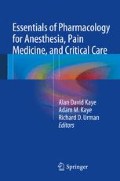Abstract
Histamine modulators, more commonly referred to as antihistamines, have been commonly used in the USA for over half a century. Many of the dangerous side effects of these medications have been minimized due to the development of more advanced formulations with the removal of the more dangerous medications from the US market by the FDA. Knowledge of the potential side effect profiles of the antihistamines is necessary for any provider who is either prescribing or administering these medications. Those negative side effect profiles include the effects on the cardiac system and the central nervous system. In addition, providers must know the effects that occur with the extremes of age and during pregnancy. Potential metabolic effects are also important aspects that must be considered when dealing with antihistamines. Remarkably, only one of the antihistamines has been assigned a boxed warning by the FDA.
Access this chapter
Tax calculation will be finalised at checkout
Purchases are for personal use only
References
Criado PR, Criado RFJ, Maruta CW, et al. Histamine, histamine receptors and antihistamines: new concepts. Braz Annals Dermatol. 2010;85(2):195–210.
Jutel M, Blaser K, Akdis CA. Histamine in chronic allergic responses. J Invest Allergy Clin Immunol. 2005;15:1–8.
Leurs R, Church MK, Taglialatela M. H1-antihistamines: inverse agonism, anti-inflammatory actions and cardiac effects. Clin Exp Allergy. 2002;32:489–98.
Monroe E, Daly A, Shalhoub R M.D. Appraisal of the validity of histamine-induced wheal and flare is used to predict the clinical efficacy of antihistamines. J Allergy Clin Immunol. 1997;99(2):S789–806.
Nicolas JM. The metabolic profile of second-generation antihistamines. Allergy. 2000;55 Suppl 60:46–52.
Lin S. Antihistamines. In: Sinatra R, Jahr J, Watkins-Pitchford J, editors. The essence of analgesia and analgesics. New York: Cambridge University Press; 2011. p. 391–6.
Davila I, Sastre J, Bartra J, del Cuvillo A, Jauregui I, Montoro J, et al. Effect of H1 antihistamines upon the cardiovascular system. J Investig Allergol Clin Immunol. 2006;16 Suppl 1:13–23.
Rumore MM, Schlichting DA. Analgesic effects of antihistaminics. Life Sci. 1985;36(5):403–16.
Kornhuber J, Parson CG, Hartnamm S, et al. Orphenadrine is an uncompetitive N-methyl-D-aspartate (NMDA) receptor antagonist: binding and patch clamp studies. J Neural Transm Gen Sect. 1995;102(3):237–46.
Boustani M, Hall KS, Lane KA, et al. The association between cognition and histamine-2 receptor antagonists in African Americans. J Am Geriatr Soc. 2007;55(8):1248–53.
Powell RJ, Du Toit GI, Siddique N, Leech SC, Dixon TA, Clark AT, British Society for Allergy and Clinical Immunology (BSACI), et al. BSACI guidelines for the management of chronic urticaria and angio-oedema. Clin Exp Allergy. 2007;37:631–50.
Gill SK, O’Brien L, Koren G. The safety of histamine 2 (H2) blockers in pregnancy: a meta-analysis. Dig Dis Sci. 2009;54:1835–8.
Humphries TJ, Merritt GJ. Review article: drug interactions with agents used to treat acid-related diseases. Aliment Pharmacol Ther. 1999;13 Suppl 3:18–26.
Kirch W, Hoensch H, Janisch HD. Interactions and non-interactions with ranitidine. Clin Pharmacokinet. 1984;9(6):493–510.
U.S. Food and Drug Administration[Internet]. Postmarket drug safety information for patients and providers. Information for healthcare professionals – intravenous promethazine and severe tissue injury, including gangrene. (updated 09/16/2009). Available from http://www.fda.gov/Drugs/DrugSafety/PostmarketDrugSafetyInformationforPatientsandProviders/DrugSafetyInformationforHeathcareProfessionals/ucm182169.htm.
Author information
Authors and Affiliations
Editor information
Editors and Affiliations
Chemical Structures
Chemical Structure 22.1
Chlorphenamine
Chemical Structure 22.2
Hydroxyzine
Chemical Structure 22.3
Promethazine
Chemical Structure 22.4
Cimetidine
Chemical Structure 22.5
Ranitidine
Rights and permissions
Copyright information
© 2015 Springer Science+Business Media New York
About this chapter
Cite this chapter
Yarborough, M., Johnson, J.G. (2015). Histamine Modulators. In: Kaye, A., Kaye, A., Urman, R. (eds) Essentials of Pharmacology for Anesthesia, Pain Medicine, and Critical Care. Springer, New York, NY. https://doi.org/10.1007/978-1-4614-8948-1_22
Download citation
DOI: https://doi.org/10.1007/978-1-4614-8948-1_22
Published:
Publisher Name: Springer, New York, NY
Print ISBN: 978-1-4614-8947-4
Online ISBN: 978-1-4614-8948-1
eBook Packages: MedicineMedicine (R0)

